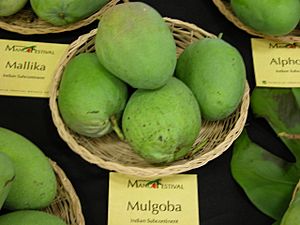Mulgoba facts for kids
Quick facts for kids Mangifera 'Mulgoba' |
|
|---|---|

Display of 'Mulgoba' mango at the Redland Summer Fruit Festival, Fruit and Spice Park, Homestead, Florida
|
|
| Genus | Mangifera |
| Cultivar | 'Mulgoba' |
| Origin | India |
The Malgova or Malgoa is a special type of mango called a cultivar. It is mostly grown in Tamil Nadu and Karnataka in South India. This mango is big and round, usually weighing between 300 to 500 grams. It has a small, hard seed inside and is very juicy and smells wonderful. Many people think it's one of the best mangoes around!
You can find Malgova mangoes growing in areas like Salem, Dharmapuri, and Krishnagiri in Tamil Nadu. They also grow in parts of Andhra Pradesh and Karnataka.
A different version of this mango, called Mulgoba, was brought to Florida in the United States. It's thought that the name 'Mulgoba' might have been a mistake when it was first labeled. There's also a similar type grown in Malaysia. The 'Mulgoba' in the US is a bit smaller and might even be a slightly different kind of mango. Scientists have studied the DNA of many mango types and found that the Malgova mango is quite unique compared to others.
What Does the Malgova Mango Look Like?
The Malgova mango is round and stays green even when it's ripe, though it might have hints of red. It has a roundish shape with a slightly flat top and a small bump on the side. The seed inside is small compared to the size of the fruit.
The 'Mulgoba' variety grown in Florida is more yellowish and can have a reddish blush. The part you eat, called the flesh, is yellow and soft. It doesn't have fibers, which means it's smooth to eat. It tastes rich, a bit spicy, and sweet. This mango has a single seed, which is called a monoembryonic seed.
Malgova mangoes ripen later in the season. They are usually picked around May in India, and in July or August in Florida. The fruit is not very sour, with a low acidity level.
How the Mulgoba Mango Came to the United States

People have wondered how the American 'Mulgoba' mango first arrived. We know that 'Mulgoba' trees were sent from India to the US in 1889. This was part of a plan to bring tropical fruits to America.
Twelve mango trees, which had been grafted (meaning a part of one tree was joined to another), were shipped by G. Marshall Woodrow. He was a professor of horticulture (the science of growing plants) in Poona, India. The trees traveled from Bombay to Washington, D.C., but they arrived in poor condition.
These trees included different types like 'Alphonse', 'Banchore', and 'Mulgoba'. Once they arrived, they were sent to south Florida to be cared for by plant experts. Five of the trees went to Professor Elbridge Gale near Lake Worth Lagoon. One of these trees was labeled "Mulgoba" by Woodrow. It's very likely this was a mistake, and it was actually a Malgova, which was a famous mango in India.
By 1895, 10 of the 12 trees had died, probably because of a big freeze in Florida during the winter of 1894-1895. In 1898, Professor Gale reported that only two trees were left: an 'Alphonse' tree and his 'Mulgoba' tree. The 'Alphonse' wasn't doing well, but the 'Mulgoba' tree produced its first fruit that same year.
However, the fruit from this 'Mulgoba' tree didn't look like the 'Mulgoba' mangoes in India or any other known Indian mangoes. This led to different ideas about where the American 'Mulgoba' came from. One idea is that the tree sent to the US was not 'Mulgoba' but another unknown type. Another idea is that the top part of the grafted tree died in the freeze, and the bottom part (the rootstock) grew and produced the fruit. If this happened, it would mean the 'Mulgoba' came from a random seedling.
After the first 'Mulgoba' tree started growing fruit, people quickly loved its amazing taste and bright color. Because of this, more 'Mulgoba' trees were grown and planted in Florida.
The 'Mulgoba' mango is also important because it was a parent to the famous Haden mango. The 'Haden' mango grew from a 'Mulgoba' seed. The 'Haden' mango then became the parent of many other Florida mangoes, so most Florida mangoes today are related to 'Mulgoba'. 'Mulgoba' was also thought to be a parent of the 'Lancetilla' and 'Keitt' mangoes, though later studies showed 'Keitt' probably wasn't from 'Mulgoba'.
Even though 'Mulgoba' tasted great, it didn't produce many fruits consistently in Florida. Because of this, people planted fewer 'Mulgoba' trees once 'Haden' and other better-producing types were developed. 'Mulgoba' never became a big commercial mango, and you can't buy young 'Mulgoba' trees from nurseries anymore. However, 'Mulgoba' trees are still kept in special collections at places like the USDA in Miami, the University of Florida's Tropical Research and Education Center, and the Miami-Dade Fruit and Spice Park in Homestead, Florida. These places help preserve different types of plants.

